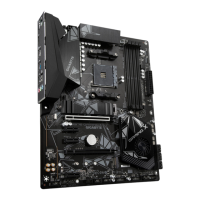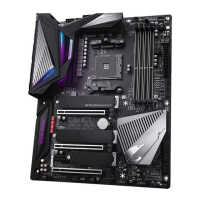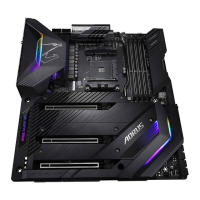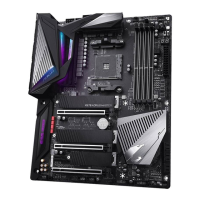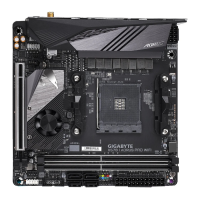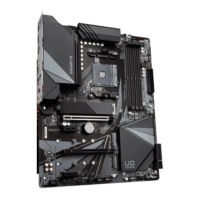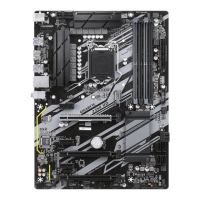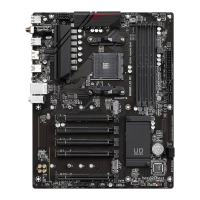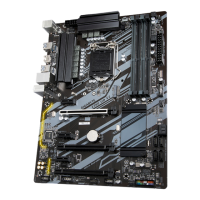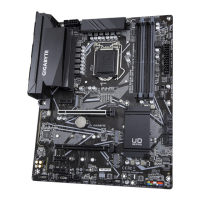Do you have a question about the Gigabyte X570 UD and is the answer not in the manual?
Essential safety guidelines and procedures to follow before installing hardware components.
Step-by-step guide for correctly installing the CPU into the socket.
Step-by-step guide for correctly installing memory modules into the DIMM slots.
Explanation of dual channel memory setup and optimal module placement.
Describes the initial BIOS startup screen and explains essential function keys for navigation.
Explanation of function keys for navigating and interacting within the BIOS Setup utility.
Configuration options for CPU clock, frequency, and GPU clock.
Sets the overall boot order from available storage and network devices.
Enables or disables Fast Boot for a quicker system boot process.
Resets BIOS settings to factory defaults for optimal system operation.
Introduction to RAID levels, preparation, and configuring the SATA controller.
Instructions for using the Xpress Install utility to automatically install drivers.
Essential safety guidelines and procedures to follow before installing hardware components.
Step-by-step guide for correctly installing the CPU into the socket.
Step-by-step guide for correctly installing memory modules into the DIMM slots.
Explanation of dual channel memory setup and optimal module placement.
Describes the initial BIOS startup screen and explains essential function keys for navigation.
Explanation of function keys for navigating and interacting within the BIOS Setup utility.
Configuration options for CPU clock, frequency, and GPU clock.
Sets the overall boot order from available storage and network devices.
Enables or disables Fast Boot for a quicker system boot process.
Resets BIOS settings to factory defaults for optimal system operation.
Introduction to RAID levels, preparation, and configuring the SATA controller.
Instructions for using the Xpress Install utility to automatically install drivers.
| Processor socket | Socket AM4 |
|---|---|
| Processor manufacturer | AMD |
| Compatible processor series | AMD Ryzen 3 2nd Gen, AMD Ryzen 3 3rd Gen, AMD Ryzen 5 2nd Gen, AMD Ryzen 5 3rd Gen, AMD Ryzen 7 2nd Gen, AMD Ryzen 7 3rd Gen, AMD Ryzen 9 3rd Gen |
| Maximum number of SMP processors | 1 |
| Audio chip | Realtek ALC887 |
| Cooling type | Active |
| Component for | PC |
| Motherboard chipset | AMD X570 |
| PC health monitoring | FAN, Temperature, Voltage |
| Audio output channels | 5.1 channels |
| Motherboard form factor | ATX |
| Windows operating systems supported | Windows 10 Education x64, Windows 10 Enterprise x64, Windows 10 Home x64, Windows 10 Pro x64 |
| ECC | Yes |
| Memory channels | Dual-channel |
| Memory slots type | DIMM |
| Number of memory slots | 4 |
| Supported memory types | DDR4-SDRAM |
| Maximum internal memory | 128 GB |
| Supported memory clock speeds | 2133, 2400, 2667, 2933, 3200, 3333, 3400, 3466, 3600, 3733, 3800, 3866, 4000 MHz |
| PCI Express x1 (Gen 3.x) slots | 2 |
| RAID levels | 0, 1, 10 |
| Supported storage drive types | HDD & SSD |
| Supported storage drive interfaces | M.2, SATA III |
| Maximum graphics card memory | 16000 MB |
| Parallel processing technology support | 2-Way CrossFireX, Quad-GPU CrossFireX |
| Number of SATA III connectors | 6 |
| USB 3.2 Gen 2 (3.1 Gen 2) connectors | 0 |
| BIOS type | UEFI AMI |
| ACPI version | 5.0 |
| BIOS memory size | 128 Mbit |
| Desktop Management Interface (DMI) version | 2.7 |
| USB 2.0 ports quantity | USB 2.0 ports have a data transmission speed of 480 Mbps, and are backwards compatible with USB 1.1 ports. You can connect all kinds of peripheral devices to them. |
| Wi-Fi | No |
| Ethernet interface type | Gigabit Ethernet |
| Cables included | SATA |
| Bundled software | Norton Internet Security (OEM) Realtek 8118 Gaming LAN Bandwidth Control |
| Depth | 244 mm |
|---|---|
| Width | 305 mm |
